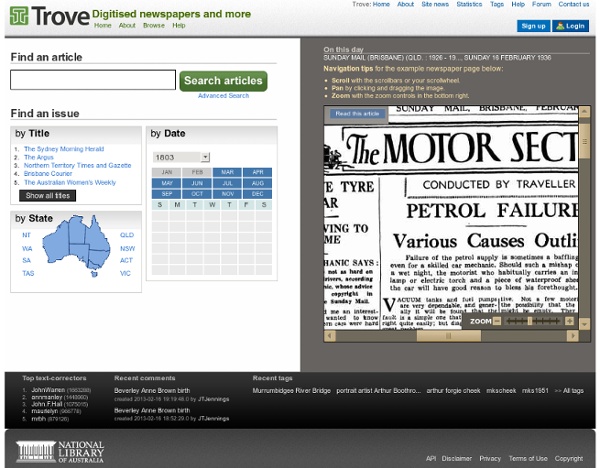



Ressources documentaires de l'IRD Aide | RSS | Authentification La base de ressources documentaires de l'IRD Publications scientifiques de l'IRD 86 000 documents issus des recherches de l'IRD 58 000 fichiers téléchargeables Recherche dans les publications Voir aussi la recherche avancée Parmi les dernières publications enregistrées : Centres de documentation Le catalogue collectif permet de rechercher dans les 130 000 références disponibles et de localiser les documents dans chacun des 13 centres de documentation du réseau IRD. Recherche dans le catalogue collectif Voir aussi la recherche avancée
Mariners and Ships in Australian Waters 10 Million newspaper pages in Trove « Behind the scenes We are proud to announce that as of today there are now TEN MILLION historic Australian newspaper pages available in Trove! The lucky edition is the Saturday July 31, 1915 issue of The Leader, from the NSW city of Orange. We are also celebrating the milestone of almost ONE HUNDRED MILLION articles within those pages which can be individually searched and referenced. Front page of Orange's 'The Leader' - Saturday July 31, 1915 This represents a milestone for the National Library initiative, the Australian Newspaper Digitisation Program, which was launched in 2008 as a project to provide free access to text-searchable digitised Australian newspapers. Staff portrait from the Orange Leader (and their dog) c1900. It is fitting that as Australia prepares to mark the centenary of the First World War, that a newspaper from 1915 should be the 10 millionth edition in Trove. Local brothers receive a farewell before heading to war... The Australian Newspapers Digitisation Project team
Welcome to OHCRA Government and Police Gazettes | Genealogy in New South Wales Blog Government Gazettes and Police Gazettes are an enormously rich source of information for family historians. They can be useful for filling in some of the detail about the lives of our ancestors, and in many cases can solve mysteries. Government gazettes contained all the administrative detail that affected the lives of ordinary citizens going about their daily lives – such as laws and regulations, licenses, land auctions and sales, unclaimed mail, and much, much more. Records of convict assignments and absconding may appear nowhere else but here. Sailors who deserted their ships are listed, as are government employees. Court notices of probate and bankruptcies, livestock brands, and petitions. Your ancestor should be in a government gazette if he or she: Notices of this type were published in the local colonial newspaper until a regular government publication was established: Police gazettes are where the juicy stuff was going on. Police Gazettes were published in the following years:
National Library of Australia The internet is a valuable aid to research into family history. These Australian sites contain a variety of information relating to family history and genealogy including guides, indexes and digitised images of documents. They also provide links to other informative sites both in Australia and overseas and pathways to make contact with other family historians via indexed family trees, mailing lists and bulletin boards. Further online resources for family history can be located via eResources, although some of these subscription resources are only available for use in the National Library reading rooms. State and Territory libraries State and territory libraries hold family history collections specialising in resources for their jurisdiction and a selection of material relating to other areas of Australia and overseas. National, State and Territory archives The National Archives of Australia holds the records of the Commonwealth government. Family history societies Births, marriages and deaths
Digital collection makes family history research easy - ABC Brisbane - Australian Broadcasting Corporation If you have ever felt put off by the time and money required to research your family history, a new web service from Queensland's Births, Deaths and Marriages office may help to change your mind. All you need is a name, and you can use the website to easily search through a database containing 650,000 historical documents. Once you've found what you're looking for, a scanned copy costs $20 to download, almost half the cost of a hard copy certificate ordered over the counter. Margaret Doherty from the Geneological Society of Queensland says she thinks the changes will allow more people to research their family history. And she says the price drop in particular will encourage people to look beyond their immediate family. "Queensland was very expensive to get a birth, death or marriage certificate at $39," she said. "Now it's $20 and downloaded immediately, and it's a copy of the actual register, rather than a transcription, which could have errors." Birth records of famous Queenslanders
Ce site offre la possibilité d'imprimer le texte découvert ou de l'extraire au format .PDF by genea.nc Mar 22